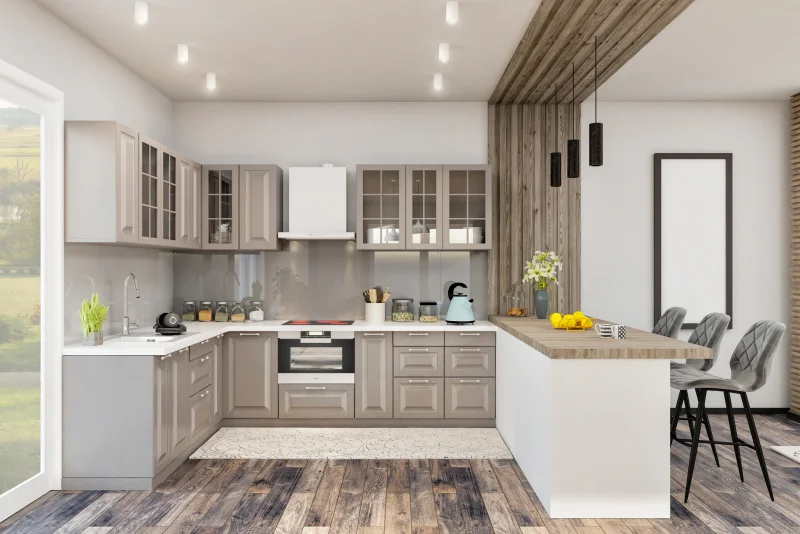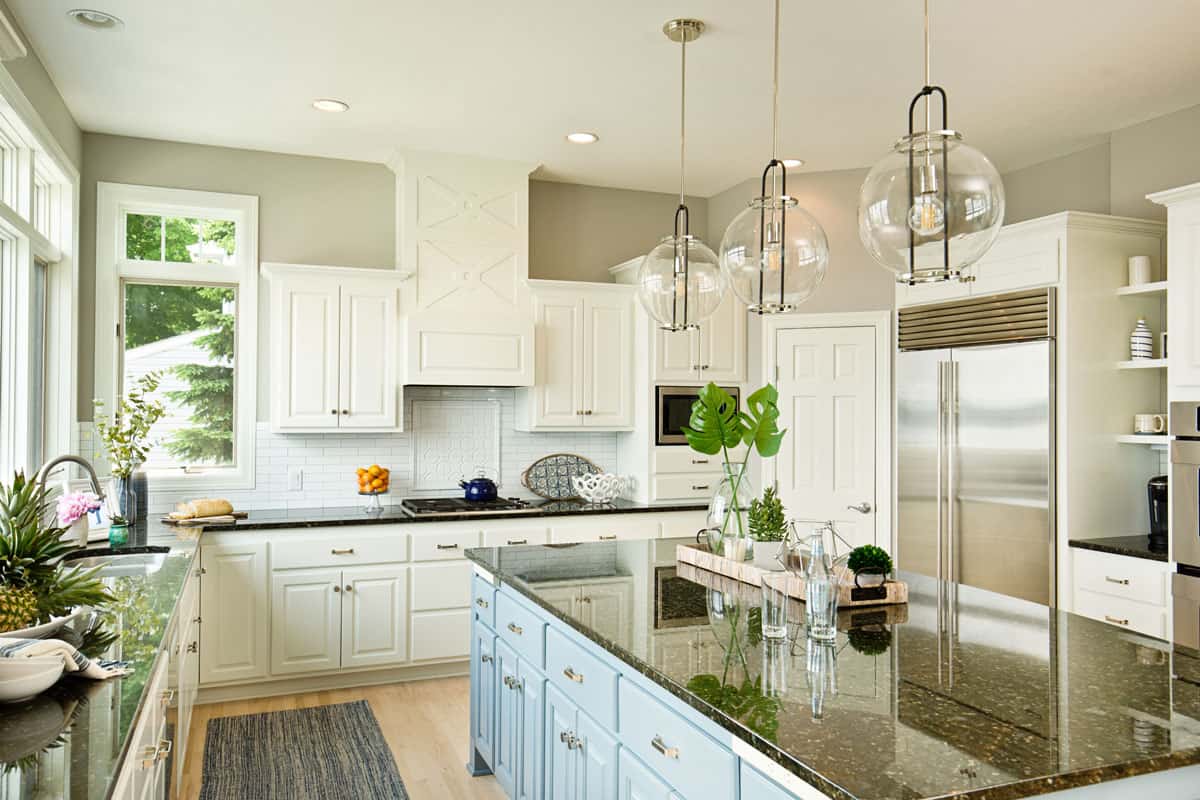Benefits of Raising Kitchen Cabinets to the Ceiling

Raising kitchen cabinets to the ceiling is a smart design choice that maximizes vertical space, creating a sleek and efficient kitchen environment. This approach offers both aesthetic and practical advantages, transforming your kitchen into a functional and stylish haven.
Aesthetic Advantages
Raising cabinets to the ceiling eliminates the visual clutter of open space above cabinets, creating a clean and uncluttered aesthetic. This streamlined look adds a sense of spaciousness and sophistication to the kitchen. The uninterrupted lines of the cabinets draw the eye upwards, making the room feel larger and more inviting. The smooth transition from cabinets to ceiling also creates a sense of unity and cohesion, enhancing the overall design harmony of the kitchen.
Increased Storage and Functionality
The primary benefit of raising cabinets to the ceiling is the significant increase in storage space. This vertical space, often left unused, becomes a valuable asset for storing items that are frequently used or infrequently accessed. The additional storage space can be used for a variety of purposes, such as storing dishes, appliances, pantry items, or seasonal items. By maximizing vertical space, you can free up valuable counter and floor space, making your kitchen more functional and efficient.
Enhanced Kitchen Flow and Efficiency
Raising cabinets to the ceiling can significantly enhance the flow and efficiency of a kitchen. By eliminating the unused space above cabinets, you create a more streamlined and organized environment. This allows for easier access to frequently used items, reducing the need to reach high or search through cluttered shelves. The increased storage capacity also helps to minimize clutter, creating a more spacious and inviting kitchen that is a pleasure to work in.
Design Tips for Incorporating Raised Cabinets
- Consider the height of your ceiling. If you have high ceilings, raised cabinets can be an effective way to utilize the extra space. However, if you have low ceilings, raised cabinets may make the room feel cramped.
- Choose the right cabinet style. There are a variety of cabinet styles available, so choose one that complements your kitchen design. For example, if you have a modern kitchen, consider sleek, minimalist cabinets. If you have a traditional kitchen, choose cabinets with more ornate details.
- Incorporate lighting. Raised cabinets can create shadows, so it is important to incorporate adequate lighting. Under-cabinet lighting can illuminate the countertop and work area, while overhead lighting can brighten the entire room.
- Use a ladder or step stool. While raised cabinets provide easy access to stored items, you may need a ladder or step stool to reach the highest shelves.
Considerations for Raising Kitchen Cabinets

Raising kitchen cabinets to the ceiling can be a transformative project, but it’s not without its considerations. This decision involves careful planning, understanding potential limitations, and making informed choices about cabinet styles and materials.
Ceiling Height
The height of your ceiling is a primary factor in determining if raising cabinets is feasible. Cabinets that reach the ceiling can make a room feel taller and more spacious, but only if there’s enough vertical space. For example, a standard 8-foot ceiling might not leave enough room for upper cabinets and adequate clearance for appliances and lighting fixtures. If you have lower ceilings, you might consider raising cabinets only to a specific height, leaving a gap at the top for visual appeal.
Structural Considerations
Raising cabinets to the ceiling requires careful consideration of the existing structure. You’ll need to ensure that the walls and ceiling are strong enough to support the added weight. A structural engineer can assess the load-bearing capacity of your kitchen and provide recommendations for reinforcing the structure if necessary.
Access Issues
Raising cabinets to the ceiling can limit access to the upper cabinets, especially if you have a standard step ladder. To address this, consider incorporating features like pull-down or lift-up doors, or installing a custom ladder system. This will ensure easy access to the upper cabinets without sacrificing the visual appeal of the ceiling-height design.
Cabinet Styles and Materials, Raise kitchen cabinets to ceiling
The style and materials of your cabinets are crucial for raised cabinets. Consider the following:
Cabinet Styles
- Frameless Cabinets: Frameless cabinets offer a clean, modern aesthetic and are often preferred for raised installations. They maximize storage space and provide a seamless look.
- Framed Cabinets: Framed cabinets are a traditional choice with a more detailed appearance. They offer a more robust construction and can be suitable for raised installations, but they might require careful planning to ensure proper alignment and functionality.
Cabinet Materials
- Wood: Wood cabinets offer durability, warmth, and a classic look. They come in various finishes and can be customized to match your kitchen’s style.
- Thermofoil: Thermofoil cabinets are made with a laminate covering over MDF, offering a smooth, easy-to-clean surface. They are available in a wide range of colors and finishes, making them a budget-friendly option.
- Painted Cabinets: Painted cabinets provide endless customization options. You can choose any color or finish to match your kitchen’s aesthetic.
Design and Implementation Strategies: Raise Kitchen Cabinets To Ceiling

Raising kitchen cabinets to the ceiling can transform your kitchen’s aesthetic and functionality, maximizing storage space and creating a sleek, modern look. Planning and executing this project effectively requires a strategic approach, encompassing careful design, proper tools, and precise installation techniques.
Planning and Design Considerations
Planning is crucial for a successful cabinet raising project. This involves assessing your kitchen’s layout, determining the desired cabinet height, and considering potential obstacles.
- Measure and Assess: Begin by accurately measuring the height of your existing cabinets and the distance between the top of the cabinets and the ceiling. Consider the height of any obstacles, such as light fixtures, ventilation systems, or beams.
- Determine the Desired Height: Decide on the desired height for your raised cabinets. This might be up to the ceiling or a specific distance below it.
- Consider the Cabinet Material: If your existing cabinets are made of solid wood, you may need to reinforce them to support the added weight.
- Plan for Ventilation: If you are raising cabinets to the ceiling, ensure proper ventilation to prevent moisture buildup and potential mold growth.
Essential Tools and Materials
To raise kitchen cabinets to the ceiling, you will need a set of essential tools and materials to ensure a smooth and successful installation process.
- Measuring Tape: For accurate measurements of existing cabinets, ceiling height, and any obstacles.
- Level: To ensure the cabinets are installed level and plumb.
- Stud Finder: To locate wall studs for securing the cabinets.
- Drill and Driver: For drilling pilot holes and securing screws.
- Saw (Circular or Jigsaw): To cut the cabinet boxes and back panels to the desired height.
- Screwdriver: For assembling and securing cabinet components.
- Safety Glasses and Gloves: To protect your eyes and hands during the project.
- Wood Filler: To fill any gaps or holes after cutting and assembling the cabinets.
- Sandpaper: To smooth out the edges and surfaces after cutting and filling.
- Paint or Stain: To match the existing cabinets or create a new look.
Installation Steps
Raising kitchen cabinets to the ceiling involves a series of steps, each requiring precision and attention to detail.
- Prepare the Cabinets: Carefully measure and cut the cabinet boxes and back panels to the desired height. Ensure all cuts are clean and precise.
- Remove Existing Cabinets: Carefully remove the existing cabinets from the wall, ensuring you disconnect any plumbing or electrical connections.
- Install the Support Structure: Install a support structure to the wall using wall studs. This structure will support the weight of the raised cabinets.
- Install the Raised Cabinets: Attach the raised cabinets to the support structure, ensuring they are level and plumb. Secure the cabinets to the wall studs.
- Finish and Decorate: Fill any gaps or holes with wood filler, sand the surfaces smooth, and paint or stain the cabinets to match the existing decor.
Maximizing Storage and Organization
Raising cabinets to the ceiling creates ample storage space, but maximizing its potential requires thoughtful organization.
- Utilize Vertical Space: Install shelves, drawers, and pull-out baskets to maximize vertical space.
- Organize by Category: Group similar items together for easy access.
- Use Clear Bins and Containers: This allows for easy visibility and identification of items.
- Label Everything: Clear labeling ensures you know what is stored where.
- Implement a Rotation System: Regularly rotate items to ensure they are not forgotten or expired.
Raise kitchen cabinets to ceiling – Raising kitchen cabinets to the ceiling can be a smart move to maximize storage space, but it’s important to consider the space between top and bottom cabinets. A well-planned gap allows for easy access to the upper cabinets and prevents a cramped feeling in the kitchen.
By carefully considering these factors, you can ensure your kitchen design is both functional and aesthetically pleasing.
Raising kitchen cabinets to the ceiling maximizes storage space and creates a sleek, modern look. After you’ve installed your cabinets, consider using parker & bailey kitchen cabinet cream to give them a beautiful, long-lasting finish. This cream helps protect your cabinets from scratches, stains, and everyday wear and tear, ensuring they stay looking their best for years to come.
By raising your cabinets and using a high-quality cream like Parker & Bailey, you’ll create a kitchen that’s both stylish and functional.
